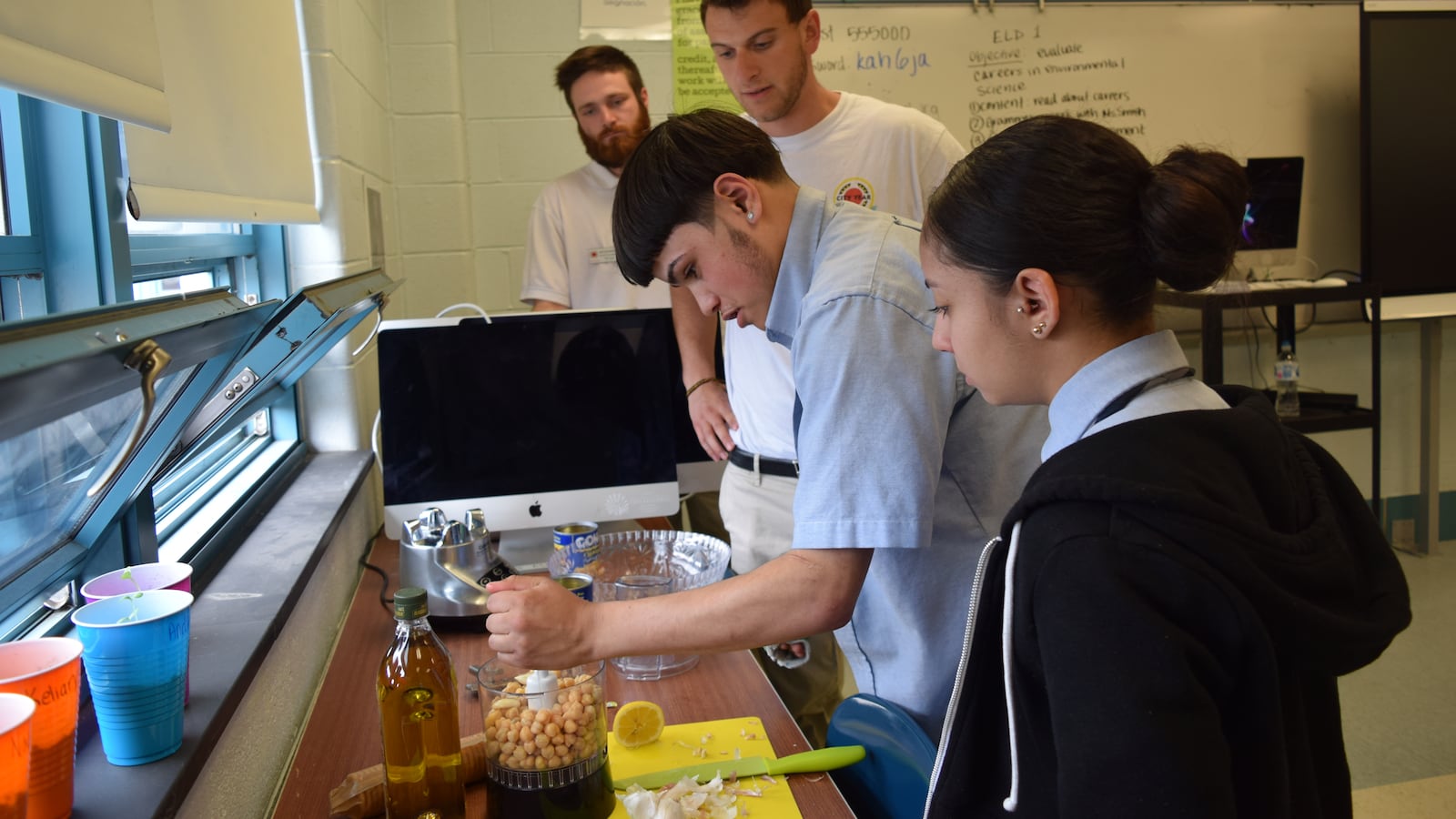This article was originally published in The Notebook. In August 2020, The Notebook became Chalkbeat Philadelphia.
Destiny Crawford, 17, talked of helping with the cooking for an 11-person household.
Sonialys Soto, 15, happy to eat less junk food, talked of helping her mother make healthy meals at home.
Nestor Quiros, 16, eased his way into the world of hummus, calling it “not bad.”
All three students at Kensington Health Sciences Academy are members of cooking clubs designed to teach them about healthy, reasonably priced, easy-to prepare meals. The hope is that what they learn won’t stop at the school’s front entrance, but will be taken home.
Kensington Health Sciences Academy is one of 12 community schools in Philadelphia. Its community schools coordinator, Antonio Romero, said that in many cases, a student is the primary cook for the family while the parent is at work. “It happens more often than you think,” he said.

The Kensington academy is also one of several schools where members of the school community identified healthy cooking and eating as a priority.
The students are “trying new foods, and if they’re the ones preparing it themselves, there’s pride of ownership,” says Laura Crandall, Healthy Schools specialist for the network. “They’re more likely to try a new fruit or vegetable.”
Although the after-school cooking classes at the Kensington academy are unusual, Crandall says experiments to spread the gospel of healthy, inexpensive meals are underway at other schools, including a farm stand at South Philadelphia High School, food pantries at Logan Elementary School and Tilden Middle School, and the donated Philabundance Backpack Program, through which students receive a weekly allotment of nonperishable items, plus one fruit or vegetable.
At the Kensington academy, both clubs use donated foods from the Sav-a-Lot supermarket chain and Philabundance, but they operate somewhat differently.
At the club that meets weekly in the school kitchen and is subsidized by the Vetri Foundation, University of Pennsylvania student Delaney Taylor was helping the students prepare salmon cakes and sweet potato fries.
Other recipes have included cornflaked chicken, which is healthier than regular fried chicken, and breakfast burritos.
The recipes “are healthy and they’re fairly cheap,” Crawford said.
The second club meets every other week and is supervised by AmeriCorps volunteers from the City Year nonprofit agency.
It meets in a classroom, so there is no cooking. And none of the recipes can take too long to prepare, which was why the volunteers rejected a request to have the students make chili.
Instead, on one recent day, the students were preparing hummus, a dish that had been unfamiliar to them.
As volunteer Will Sever laid out the ingredients — canned chickpeas, tahini, olive oil, garlic, and salt — Nestor Quiros said he wasn’t sure he’d like it.
“You’ll like it this time,” joked volunteer Julian Cohen. And after chopping the garlic and adding the salt, Quiros seemed to warm up to it.
Although the students are, of course, learning healthy eating habits and food preparation, Romero says he hopes the lessons go beyond the culinary.
“It’s also about self-sufficiency, he said. “If they’re willing to try new things here, that’s transferable.”
The Notebook is one of 19 news organizations producing Broke in Philly, a collaborative reporting project on solutions to poverty and the city’s push towards economic justice. Read more at https://brokeinphilly.org and follow us on twitter @BrokeInPhilly
This article is part of a special online section of the Notebook that takes a look at school meals and the important role they play in providing nutrition to children in Philadelphia, the poorest among the 10 most populous U.S. cities. In Philadelphia, 26 percent of the population, and 37 percent of children – that’s 126,000 children – live under the federal poverty line, according to Shared Prosperity Philadelphia.
Read more here.
The edition is made possible by the generous support of the Leo & Peggy Pierce Family Foundation.


